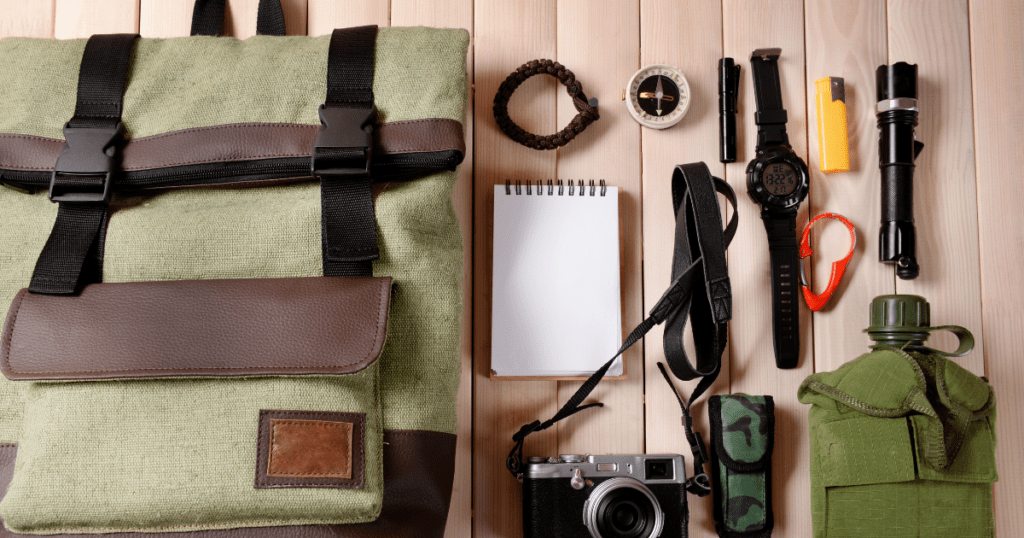For a comprehensive and precise backpacking list, consider essential items such as a backpack, sleeping bag, trekking pole, headlamp, clothing, footwear, navigation tools, first aid supplies, and food. When planning a backpacking trip, it’s vital to focus on packing light, versatile, and high-quality gear for an enjoyable and comfortable experience in the outdoors.
The right items will ensure safety, comfort, and convenience while exploring nature. Proper research and planning will help you determine the necessary gear and food items for your specific backpacking adventure. Embarking on a backpacking trip can be an exciting and rewarding experience, providing an opportunity to connect with nature and explore new landscapes.
Whether you’re a seasoned backpacker or a first-timer, having a well-prepared backpacking list is crucial for a successful and enjoyable journey. From essential gear like a reliable backpack and lightweight sleeping bag to proper footwear and navigation tools, careful consideration of each item is essential.
Moreover, selecting appropriate clothing and packing nutritious food and water are equally vital for a safe and comfortable excursion. By thorough planning and adhering to a well-curated backpacking checklist. You can ensure a memorable and fulfilling backpacking adventure.
Tailoring Your Adventure Essentials
When it comes to planning a backpacking adventure, tailoring your essential items to the specific requirements of your trip is crucial. Consideration of factors such as trip duration, destination, activities, weather, terrain, and personal needs forms the cornerstone of optimizing your adventure essentials. Adapting your packing list based on these factors. You can ensure a comfortable, safe, and enjoyable backpacking experience.
Consider Trip Duration
When preparing for a backpacking trip, the duration of your adventure plays a significant role in determining the quantity and type of items you need to pack. Longer trips may require more extensive meal planning, extra clothing, and a higher quantity of essential items such as toiletries and first aid supplies. Conversely, for short excursions, you can prioritize lightweight and minimalistic packing, focusing on only the essentials.
Destination
Every destination presents unique challenges and requirements for backpackers. Researching the specific characteristics of your destination, such as climate, altitude, and geographical features, will help you tailor your gear accordingly. For example, a trip to a tropical rainforest would necessitate insect repellents, lightweight, breathable clothing, and a reliable water purification method. Whereas a high-altitude trek may demand specialized gear for cold weather and altitude sickness prevention,
Activities
The activities you have planned for your backpacking trip significantly influence the gear and supplies you need to bring. Whether you are embarking on a hiking expedition, camping in remote areas, or engaging in water-based activities such as kayaking or rafting, each activity calls for specific equipment and provisions. Tailoring your adventure essentials to match your planned activities ensures that you have the necessary tools and resources for a memorable and safe experience.
Adapt For Weather And Terrain
Weather conditions and the terrain you will encounter during your backpacking trip are pivotal factors in determining the gear and clothing you need to pack. For example, a trip through diverse climates may require versatile clothing options, while backpacking in rugged terrain might necessitate sturdy footwear, trekking poles, and protective gear. Adapting your packing list to cater to the predicted weather and terrain will enhance your comfort and safety throughout the journey.
Personal Needs
Considering your personal requirements, preferences, and limitations is essential when tailoring your adventure essentials. This involves accounting for any specific medical conditions, dietary restrictions, or comfort items that are crucial for your well-being and enjoyment during the trip. Catering to your individual needs ensures that you have a personalized backpacking list that aligns with your unique requirements and enhances your overall experience.
Navigating With Confidence
When heading out for a backpacking trip, finding your way through diverse terrain can be a thrilling adventure. Navigating with confidence is essential to ensuring a safe and enjoyable journey. Whether you rely on traditional map reading and compass skills or prefer the modern convenience of GPS devices, having the right knowledge and tools is crucial for a successful hiking experience.
Maps And Compass/GPS Devices
When it comes to navigating the great outdoors, having the appropriate tools is key. Be sure to pack a detailed topographic map of the area you plan to explore. Pair this with a reliable compass to help you orient yourself and determine your direction. Alternatively, a GPS device can provide accurate location information and navigational assistance, particularly in unfamiliar or complex terrain.
Navigation Know-how And Resources
Equipping yourself with navigation knowledge and resources is essential for a successful backpacking trip. Familiarize yourself with map reading, understanding contour lines, and identifying landmarks. Additionally, having access to reliable trail guides, online mapping tools, and GPS apps can provide valuable support for route planning and real-time navigation assistance.
Shelter And Comfort
When you’re out in the wilderness, having the right shelter and comfort is essential for a successful backpacking trip. Ensuring a good night’s sleep and being protected from the elements can make all the difference in your outdoor adventures. Here are the key elements to consider for shelter and comfort on your backpacking list:
Tent, Bivy Sack, Or Hammock With Rain Protection
Choosing the right shelter is crucial for a comfortable night’s sleep. A tent offers full protection from the elements and privacy, while a bivy sack provides a lightweight and compact option suitable for solo travelers. For a unique sleeping experience, a hammock with rain protection offers a versatile and comfortable alternative, especially in areas with trees.
Sleeping Bag Rated For Temperature And Insulation
Your sleeping bag is your insulation from the cold, making it an essential item for your comfort. Ensure you select a sleeping bag that is rated for the anticipated temperature during your backpacking trip. Consider the insulation type to match the conditions you expect to encounter. This careful selection will make a significant difference in the quality of your sleep and overall comfort during your outdoor adventures.
Sustenance Strategies
When embarking on a backpacking adventure, sustenance is a crucial aspect to plan for. From staying hydrated to fueling your body with nourishing food, your packing list should include items that cater to these basic needs. In this section, we will delve into two key aspects of sustenance strategies: water filtration and water bottles/hydration systems, as well as cookware, stoves, fuel, and food planning.
Water Filtration And Water Bottles/hydration System
Ensuring a safe and adequate water supply is paramount in the wilderness. Water filtration systems are indispensable for purifying water from natural sources such as streams and lakes. Invest in reliable water filters or purification tablets that eradicate harmful pathogens, safeguarding you from waterborne illnesses.
Additionally, having a dependable water bottle or hydration system is essential for on-the-go access to hydration. Look for lightweight, durable bottles or hydration bladders that are easy to refill and carry, enabling you to stay hydrated throughout your adventure.
Cookware, Stove, Fuel, And Food Planning
When it comes to sustenance strategies, proper food planning and cooking equipment are imperative. Opt for lightweight cookware that suits your specific needs, whether it’s a compact stove, cooking pot, or utensils. This will allow you to prepare nutritious meals during your journey.
Don’t forget to pack fuel for your stove, ensuring you have an adequate supply for the duration of your trip. Efficiently planned meals, such as dehydrated or freeze-dried options, can minimize the need for excessive fuel usage, lightening your load.
An organized food planning approach is fundamental for maintaining energy levels. Consider lightweight, high-calorie foods that require minimal preparation, such as dehydrated meals, energy bars, nuts, and dried fruits. Planning your meals will streamline your cooking process and ensure you have sufficient sustenance for your backpacking journey.
Dress For Success Outdoors
When gearing up for a backpacking trip, choosing the right clothing and footwear is crucial for ensuring comfort, protection, and mobility while trekking through various terrains. Here’s a breakdown of essential considerations for dressing for success outdoors.
Layered Clothing Approach
Layering is key to being prepared for fluctuating weather conditions during backpacking adventures. Utilizing a layered clothing approach helps regulate body temperature and manage moisture, providing comfort and protection throughout the journey. The three primary layers include:
- Base layer: moisture-wicking and breathable fabrics to keep the skin dry.
- Insulating layer: Provides warmth, such as fleece or down jackets.
- Outer shell: a waterproof and wind-resistant jacket for protection against the elements.
Footwear Tailored To Hiking And Terrain
Footwear selection is critical to ensuring comfort, support, and traction on the trail, encompassing various factors including terrain and climate. Choosing the right hiking boots or shoes tailored to the specific conditions is essential for a successful backpacking trip, whether it’s rocky, muddy, or snowy terrain.
When venturing into rugged terrain, sturdy and supportive hiking boots with ankle support are ideal to reduce the risk of ankle injuries. On the other hand, for less demanding trails, lightweight trail shoes offer agility and breathability.
Regardless of the choice, it’s crucial to break in the footwear before the trip to prevent discomfort and blister formation during the journey. An appropriate fit, excellent traction, and waterproofing capability are vital elements to consider when selecting hiking footwear.
First Aid And Emergency Preparedness
When embarking on a backpacking adventure, it’s crucial to prioritize safety and preparedness. Ensuring you have the necessary first-aid resources and knowledge, as well as emergency signaling devices and tools, can make all the difference in unforeseen situations.
First Aid Kit And Knowledge Of Use
One of the most critical components of any backpacking trip is a well-equipped first-aid kit. It should contain essentials such as adhesive bandages, gauze pads, antiseptic wipes, tweezers, scissors, pain relievers, and any personal medications. Additionally, knowing how to utilize the items in the kit is equally important; therefore, it’s advisable to have basic first-aid training before setting out on the journey.
Emergency Signaling Devices And Tools
In the event of an emergency, having the means to signal for help is crucial. Consider carrying emergency signaling devices such as a whistle, mirror, or signal flares, as they can attract attention and aid in rescue efforts. It’s also essential to have a reliable multi-tool that can serve various functions, such as cutting, opening cans, and even providing some basic repair capabilities.
Minimizing Pack Weight And Maximizing Enjoyment
When backpacking, reducing the weight of your pack can significantly enhance your overall experience, allowing you to move more freely and enjoy the journey without unnecessary strain. Efficient packing helps strike a balance between essentials and comfort items. Ensuring that you have everything you need while keeping the load manageable.
Multi-functional Items And Lighter Alternatives
One effective way to minimize pack weight is to incorporate multi-functional items and opt for lighter alternatives. Investing in multi-purpose gear such as a headlamp with a built-in whistle or a jacket that doubles as a pillow can help save space and reduce the weight of your pack. Additionally, consider replacing heavy items with lighter alternatives, such as using a lightweight tarp instead of a traditional tent or packing dehydrated meals to cut down on food weight.
Balance Between Essentials And Comfort Items
Finding the right balance between essential gear and comfort items is crucial for a successful backpacking trip. Ensure that you have the necessary equipment for safety, navigation, and emergencies, but also allow yourself a few comfort items to enhance your enjoyment along the trail. Prioritize lightweight, compact versions of essential items while carefully selecting comfort items that bring value to your experience without adding excessive weight to your pack. 100Travel accessories list.
Frequently Asked Questions On Backpacking List
What Do I Need for a Backpacking Trip?
For a backpacking trip, you need a backpack, sleeping bag, tent, hiking boots, clothing, food, water, navigation tools, a first aid kit, and repair items. Plan your trip, gather gear, and pack wisely for a memorable adventure.
What Are the Big Four Backpacking Items?
The big four backpacking items are a pack, tent, sleeping bag, and sleeping pad. These items are essential for a successful backpacking trip.
What Foods to Bring Backpacking?
When backpacking, bring lightweight, calorie-dense foods like nuts, dried fruits, energy bars, jerky, and instant meals. Don’t forget to pack items that require minimal prep and can be easily rehydrated with boiling water. Additionally, consider the nutritional value and ease of transportation of your food choices.
What Should I Plan for a Backpacking Trip?
When planning a backpacking trip, consider your destination, research the area, get necessary permits, create an itinerary, organize your gear, plan meals, and pack accordingly. It’s essential to have the right gear, adequate food, and a solid plan to ensure a successful adventure.
Conclusion
A well-prepared backpacking list can make or break your outdoor adventure. By considering the essentials such as gear, clothing, and food, you can ensure a safe and enjoyable trip. Furthermore, being mindful of weight and functionality will also enhance your backpacking experience.
So, take the time to plan and pack thoughtfully, and you’ll be ready for any adventure that comes your way!


